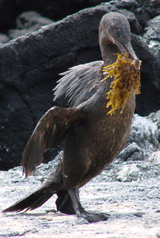Home | Tours | Trip Reports | News | Team | Calendar | Links | Contact | Store | Mailing List
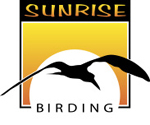 Galápagos
&
Galápagos
&Ecuador
Trip I: July 1 - 13, 2007
TRIP REPORT
TRIP 1: REPORT> SPECIES LIST>(PDF) PDF Report>(no photos)
TRIP 2: REPORT> SPECIES LIST>(PDF) PDF Report> (no photos)
LEADERS: Gina Nichol & Juan Carlos Calvachi
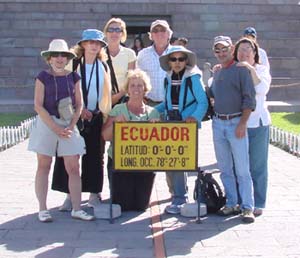 Sunday, July 1, 2007
Sunday, July 1, 2007
Joanna, Milady, Tom, Marie, Donna, Joe, and Carlyn had arrived in Quito and enjoyed a tour of Quito during the day. Back at the hotel, we enjoyed a brief respite before dinner. By now, Steve and Linda had arrived and we regaled them with our cultural adventures of the day. During dinner, Chris, Marianne, Monica, and Gregory arrived and Juan welcomed us to his wonderful country. After dinner, Chris set up his spotting scope in the garden so we could see Jupiter and its moons as the full moon brightened the sky. John finally arrived from New York and, at last, the entire group was assembled. We settled into our lovely rooms for the night serenaded by a lively fiesta next to the B&B.
Monday, July 2, 2007
Some of us enjoyed a bit of pre-breakfast birding in the garden at El Jardin where one particular Bottlebrush tree was alive with birds. Sparkling Violetears flitted through the foliage while Black-tailed Trainbearers fed on the red flowers. In a larger adjacent tree, Cinereous Conebills, Saffron Finches, Hooded Siskins, and Rusty Flowerpiercers were seen. A few Great Thrushes fed on the ground near our rooms and several Blue-and-White Swallows flew over the gardens. A Western Emerald came to a feeder near the house and then joined the fray in the Bottlebrush only to be run out by the Violetear. Vermillion Flycatcher, Southern Yellow Grosbeak, and Eared Dove were all part of the morning show on this clear, beautiful day.
After breakfast, we headed east away from Quito toward Papallacta. Along the road some Black Vultures were spotted soaring over the valley and some of us got a glimpse of an Aplomado Falcon flying over a farm field and then across the road. We turned off on Papallacta Road and stopped to scan the cliffs above a valley overlooking Quito. Hooded Siskins fed and flitted in the bushes along the road but were difficult to pinpoint. It seemed anything around was staying down out of the wind. We began walking up a trail off the road when Joanna reported a large white and black bird flying over the hillside. When we went back to check if it was a condor, we all got good flight views of a Carunculated Caracara that flew across the valley.
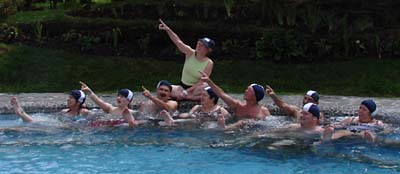 Further on, Andean Gulls were feeding in a field that was being tilled so we stopped for a few minutes to get good looks at these handsome gulls. We continued on through Papallacta Pass at 12,000 feet and arrived at Termas Papallactas hot spring resort. While most of us were in the lobby checking in to use the natural hot pools, Wilson spotted two Andean Condors soaring over the ridge above the valley. We quickly filed out to get flight views of these awesome birds winding over the ridge tops. Several of us enjoyed a soak in the naturally-fed hot pools while Milady and Donna opted for a massage. Around the pools working the flowering shrubs were Viridian Metailtail and Black Flowerpiercer, and Brown-bellied Swallows soared above. At one point, we looked up at the ridge and spotted another Andean Condor. We all agreed that a good day of birding certainly included seeing an Andean Condor while soaking in a hot pool!
Further on, Andean Gulls were feeding in a field that was being tilled so we stopped for a few minutes to get good looks at these handsome gulls. We continued on through Papallacta Pass at 12,000 feet and arrived at Termas Papallactas hot spring resort. While most of us were in the lobby checking in to use the natural hot pools, Wilson spotted two Andean Condors soaring over the ridge above the valley. We quickly filed out to get flight views of these awesome birds winding over the ridge tops. Several of us enjoyed a soak in the naturally-fed hot pools while Milady and Donna opted for a massage. Around the pools working the flowering shrubs were Viridian Metailtail and Black Flowerpiercer, and Brown-bellied Swallows soared above. At one point, we looked up at the ridge and spotted another Andean Condor. We all agreed that a good day of birding certainly included seeing an Andean Condor while soaking in a hot pool!
After our soak, some of us went to explore the ranch and forest areas above Termas. We stopped at a raging mountain stream and as we got out of the van a Scarlet-bellied Mountain-Tanager flew over. Gina spotted a brilliant Shining Sunbeam working some flowers along the road. As we walked down the road, a Brown-backed Chat-Tyrant flew across. We were drawn back to the bridge by a lovely Spectacled Whitestart working some branches above the rushing water. We walked further down the road and found another Scarlet-bellied Mountain-Tanager, this one giving great views as it fed on some berries in a tree. Joanna was particularly impressed with her scope view of this little beauty. We continued down a trail along the river and as we came in sight of a Juan and a few who had gone ahead, we saw Chris and Juan making gestures to us. We soon determined that they were trying to tell us that there was a White-capped Dipper heading up our way. We got excellent, close views of this elusive bird as well as the entertaining gestures from below.
We made our way back to the road and continued down the hill. In a few steps, Norby shouted “Buzzard-Eagle!” as a Black-chested Buzzard-Eagle soared above us. We watched it soar over the ridge and back and noted a second bird flying with it. Fabulous!
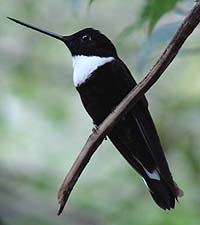 We met up with those that had stayed at the pools to relax or get massages and then headed down to Guango Lodge for lunch. After lunch, we watched the spectacle of no less than 12 species of Hummingbirds buzzing around the lodge feeders. Tourmaline Sunangel, Chestnut-breasted Coronet, Tyrian Metaltail, Glowing Puffleg, Speckled Hummingbird, Viridian Metaltail, and the tiny, bee-like White-bellied Woodstar were all part of this incredible exhibition. The Collared Inca was particularly elegant but aggressive and the stylish Buff-winged Starfrontlet was much more subdued. There were several Long-tailed Sylphs with long streaming iridescent tails but the Sword-billed Hummingbird with its extended bill stole the show. Several of us got up close and personal with the birds as they fed at the feeders and cameras clicked like mad. There were several Masked Flowerpiercers around the feeders as well, adding a lovely blue hue to the iridescent splashes. After a while, a Mountain Velvetbreast came into the fold sharing its own elegance with us.
We met up with those that had stayed at the pools to relax or get massages and then headed down to Guango Lodge for lunch. After lunch, we watched the spectacle of no less than 12 species of Hummingbirds buzzing around the lodge feeders. Tourmaline Sunangel, Chestnut-breasted Coronet, Tyrian Metaltail, Glowing Puffleg, Speckled Hummingbird, Viridian Metaltail, and the tiny, bee-like White-bellied Woodstar were all part of this incredible exhibition. The Collared Inca was particularly elegant but aggressive and the stylish Buff-winged Starfrontlet was much more subdued. There were several Long-tailed Sylphs with long streaming iridescent tails but the Sword-billed Hummingbird with its extended bill stole the show. Several of us got up close and personal with the birds as they fed at the feeders and cameras clicked like mad. There were several Masked Flowerpiercers around the feeders as well, adding a lovely blue hue to the iridescent splashes. After a while, a Mountain Velvetbreast came into the fold sharing its own elegance with us.
After spending some good quality time with these glittering birds, we tore ourselves away and headed back to El Jardin. Some of us got to know Juan’s horses and enjoyed a ball game with Daniella and Juan Andreas while others relaxed and reflected on the fantastic day of Andes birding we’d had. We had an excellent dinner and then Juan briefed us on our impending adventure in the Galápagos.
Tuesday, July 3, 2007
After breakfast, we departed from El Jardin for our flight to the Galápagos. During our brief stop in Guayaquil, a few Cattle and Great Egrets were noted along the runway. Arrived at Baltra and Efrén, a 21-year veteran Galápagos National Park guide met us to take us to our ship, the San Jose.
When we arrived at the boat dock a few Galápagos Sea Lions were there to greet us. Magnificent Frigatebirds flew above as well as Blue-footed Boobies and Common Noddies. Juan pointed out a pair of Galápagos Doves flying along the hillside and Linda spotted a Marine Iguana on a rock near the shore. On the way out to the boat, Elliot’s Storm-Petrel flew by.
We boarded the San Jose and settled into our rooms. The bell called us in for lunch which was excellent but we had difficulty sitting still as the wildlife was tempting us out. Some of us cut it short to go out on deck and see Galápagos Shearwaters, Nazca Boobies, and Wedge-rumped Storm-Petrel. Several Magnificent Frigatebirds closely followed the ship and we could almost reach out and touch them. As we sailed out on the open water we passed at least a dozen giant Manta Rays and we marveled at the awesome size of these massive creatures.
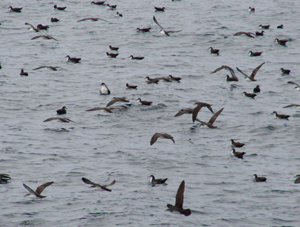 We headed toward Daphne Major, the island where Peter Grant conducted his research with Darwin’s Finches. As we neared the island we passed a flock of several hundred Galápagos Shearwaters feeding at the surface of the water. We circumnavigated the island staying close to shore and getting great looks at Swallow-tailed Gulls and Nazca Boobies flying over. On the rocks at the water’s edge, we could see several bright orange Sally Lightfoot Crabs on shore. The highlight, however, was the many Red-billed Tropicbirds flying over, some very close to the boat.
We headed toward Daphne Major, the island where Peter Grant conducted his research with Darwin’s Finches. As we neared the island we passed a flock of several hundred Galápagos Shearwaters feeding at the surface of the water. We circumnavigated the island staying close to shore and getting great looks at Swallow-tailed Gulls and Nazca Boobies flying over. On the rocks at the water’s edge, we could see several bright orange Sally Lightfoot Crabs on shore. The highlight, however, was the many Red-billed Tropicbirds flying over, some very close to the boat.
There were several feeding flocks of Brown Noddies just off shore and a Small Ground-Finch was spotted on some rocks – our first of the Darwin’s Finches! A Wandering Tattler flew out from the shore and crossed our starboard side.
From here we sailed toward the north coast of Santa Cruz and Las Bachas beach where we made our first of many wet landings on a gorgeous fine white sand beach. We found a spot on the beach to leave our gear. A large flock of Cattle Egrets appeared above the vegetation just off the beach. We walked along the trail near the water’s edge and observed several nests of Green Sea Turtles and one with fresh tracks probably made in the last day or so. Several Mangrove Warblers worked the shrubs at the edge of the beach and we encountered our first Medium Ground-Finch in the low scrub. There were the remains of barges from WWII at the water’s edge and this is how Bachas Beach got its name – baches meaning barge.
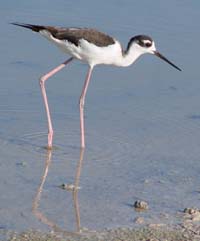 We walked along the edge of the sparkling blue water and saw a White-spotted Eagle Ray just off the beach. There were several Marine Iguanas on the beach which gave us our first of many close looks at this unique creature. A Great Blue Heron (Galápagos subspecies) stood on the beach and then walked toward a small lagoon. We headed toward the same area being careful to avoid stepping near the Green Sea Turtle nests. We scoped a Yellow-crowned Night-Heron across the lagoon as well as a few Black-necked Stilts and a Whimbrel. A Galápagos Mockingbird flew in, perched on a bush and regaled us with its call. It seemed quite curious and flew in closer to us allowing nice photos.
We walked along the edge of the sparkling blue water and saw a White-spotted Eagle Ray just off the beach. There were several Marine Iguanas on the beach which gave us our first of many close looks at this unique creature. A Great Blue Heron (Galápagos subspecies) stood on the beach and then walked toward a small lagoon. We headed toward the same area being careful to avoid stepping near the Green Sea Turtle nests. We scoped a Yellow-crowned Night-Heron across the lagoon as well as a few Black-necked Stilts and a Whimbrel. A Galápagos Mockingbird flew in, perched on a bush and regaled us with its call. It seemed quite curious and flew in closer to us allowing nice photos.
All the while, Blue-footed Boobies were flying overhead and several large groups flew by as we made our way back to the beach for snorkeling. We noticed a large flock had formed in the far end of the bay and as we watched, they started to plunge dive in an incredible feeding frenzy. The flock was at least 500 birds moving and positioning in the sky until they dove down in groups of twenty or thirty at a time into the water. We watched the spectacle for several minutes as we made our way to the beach. Some of us snorkeled while others enjoyed the late afternoon sun on the beach. Snorkeling highlights included a three-foot Moray eel, a large shark, some parrotfish, and several Sergeant Majors.
It was time to tear ourselves away from Las Bachas and go back to the San Jose. We gathered for margaritas at the bar and enjoyed our first gorgeous sunset in the Galápagos. The clear evening sky stayed lit for a long time after the sun dropped below the horizon resulting in gorgeous colors. After dark, several Brown Pelicans congregated around the boat catching Flying Fish that were being chased by Sea Lions. Two or three Galápagos Sharks showed up and we enjoyed the show from the various decks. We were invited back to the bar for the official welcome aboard by the captain and crew. An excellent dinner followed as well as a briefing on tomorrow’s happenings. We reviewed the list of species seen and were thrilled to be in this magical place.
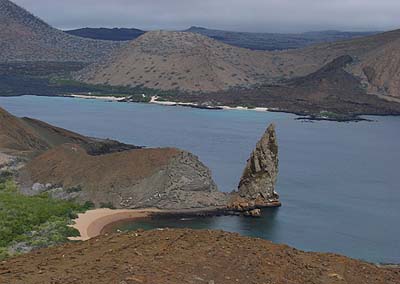 Wednesday, July 4, 2007
Wednesday, July 4, 2007
We woke up this morning in the shadow of the small, rugged island of Bartolomé. After breakfast we went ashore to hike to the summit of Bartolome at 259-feet. On the way up a Magnificent Frigatebird flew very close to us and we found several Lava Lizards. Efrén explained some of the lava formations including ah-ah and pahoehoe lava, tuff and spatter, and cinder cones, and lava tubes. He also pointed out some of the plants that grew in this stark environment including Tiquilla, Galápagos Petunia, and Lava Cactus. As we neared the summit, we enjoyed awesome views of the lava fields on Santiago. Volcanic features became more evident as we ascended and we could even see a submerged volcanic cone near where we landed. Cameras clicked in all directions in attempts to capture the magnificent landscape and the famous Pinnacle Rock.
After enjoying the spectacular views, we descended to sea level to board the zodiacs and explore the area around Pinnacle Rock. A Lava Heron was spotted beneath the dock and though it was a bit distracting for us, the bird didn’t seem to mind the group of people trying to get a look at it as it hid below the lava ledge. We saw several sea lions on the beach and got a very quick glimpse of our first Galápagos Penguin in the water. The bird disappeared quickly so we continued our search. We got great close looks  at another Lava Heron feeding and some Brown Pelicans perched up on the ledges overlooking the water. One zodiac moved ahead and motioned us over to see a Galápagos Penguin standing on a rock at water’s edge. We got stunning views of this unique species for several minutes as it posed cooperatively for photos.
at another Lava Heron feeding and some Brown Pelicans perched up on the ledges overlooking the water. One zodiac moved ahead and motioned us over to see a Galápagos Penguin standing on a rock at water’s edge. We got stunning views of this unique species for several minutes as it posed cooperatively for photos.
Finally, it was time to return to the ship to prepare for a snorkeling excursion around Pinnacle Rock. Those of us that snorkeled were treated to an excellent reef at the base of the rock. Several species of sea stars were present as well as large schools of fish. The reef was in prime condition and offered everything from corals to feather dusters to brightly colored fish. Here we also had the thrill of snorkeling with sea lions and being entertained by their fascinating antics. Curious and playful, several Sea Lions engaged several of us in their aquatic games.
After lunch, the San Jose set sail for Puerto Egas on Santiago. Several of us tried for a siesta but sightings from the ship were too exciting to allow rest! At least two dozen large Green Sea Turtles were seen swimming in the water – some very close to the ship. A White-spotted Eagle Ray put on a show by jumping out of the water several times and flipping over in mid-air. Six or more enormous Manta Rays were spotted floating at the surface. We sailed in sight of shore and Gina spotted a Galápagos Hawk perched on a high ledge. Another Spotted Eagle Ray flipped in front of us. The sheer cliffs of the islands showed amazing patterns in the exposed rock. A Lava Heron was spotted perched in a crevice on the side of one sheer face. Fantastic!
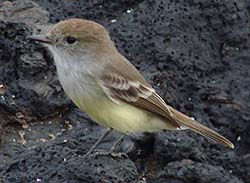 The ship anchored off the west coast of Santiago and we made a wet landing on a black sand beach at Puerto Egas. A whining Sea Lion pup drew our attention as its mother scolded it from time to time. Down the beach, a male Sea Lion was actively swimming and barking. Beyond that a Galápagos Mockingbird (mertensi subspecies) flew among the lava boulders and a lovely Galápagos Dove perched on an old water tank. We walked the trail and Efrén told us about the old salt factory that was here in the 1960s the remains of which were evident. We found several Lava Lizards along the trail.
The ship anchored off the west coast of Santiago and we made a wet landing on a black sand beach at Puerto Egas. A whining Sea Lion pup drew our attention as its mother scolded it from time to time. Down the beach, a male Sea Lion was actively swimming and barking. Beyond that a Galápagos Mockingbird (mertensi subspecies) flew among the lava boulders and a lovely Galápagos Dove perched on an old water tank. We walked the trail and Efrén told us about the old salt factory that was here in the 1960s the remains of which were evident. We found several Lava Lizards along the trail.
As we walked, Efrén pointed out some of the local plants including the Palo Negro and Muyuyu trees and Galápagos Lantana plant. Juan spotted a Galápagos Flycatcher at the trail junction as it flitted among the low vegetation. We would later get a better view of this species in the open as it foraged around the lava rocks on the beach. Juan also found a Galápagos Scorpion under a rock. The trail took us along the shoreline where we saw a Small Ground-Finch and several congregations of large Marine Iguanas. A total of four American Oystercatchers were spotted and gave close views. Chris spotted a Galápagos Hawk flying over. Joe went to the water’s edge to inspect the numerous Sally Lightfoot Crabs and a large male Sea Lion came in and chased him back up the beach. Several Mangrove Warblers hawked flies over the lava. Three Whimbrels were seen at the waters edge. Offshore we could see another Spotted Eagle Ray and several Sea Lions jumping out of the water.
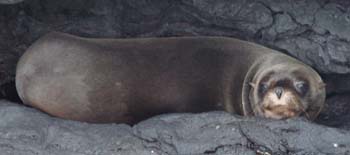 We reached a deep grotto in the lava with crystal clear water and inspected it to see where it led under the lava. In the next grotto, we found several Galápagos Fur Sea Lions and got good close looks at they frolicked in the clear water. As we watched the antics of the fur seals, we had to be careful not to step on the numerous Marine Iguanas that were lounging in the lava. Despite their size, they were difficult to see as they blended in perfectly with the lava. As we explored the area around the grottos, we noticed a Yellow-crowned Night-Heron perched on a ledge just below where Steve was standing – an excellent photo opp!
We reached a deep grotto in the lava with crystal clear water and inspected it to see where it led under the lava. In the next grotto, we found several Galápagos Fur Sea Lions and got good close looks at they frolicked in the clear water. As we watched the antics of the fur seals, we had to be careful not to step on the numerous Marine Iguanas that were lounging in the lava. Despite their size, they were difficult to see as they blended in perfectly with the lava. As we explored the area around the grottos, we noticed a Yellow-crowned Night-Heron perched on a ledge just below where Steve was standing – an excellent photo opp!
We made our way back along the return trail where at least a dozen Galápagos Mockingbirds were seen on the ground and in the low vegetation. Two more Galápagos Hawks were spotted overhead – one hovering. Back at the black beach, the male Sea Lion was now out of the water but still barking at its harem. We boarded the zodiacs back to the San Jose as it was getting dark. As darkness fell a number of Swallow-tailed Gulls could be seen flying around the boat. Some of us met at the bar for margaritas and then Jefferson served another lovely meal complete with a celebratory sculpture for the 4th of July. After dinner, several of us met in the bridge with the ship’s crew to celebrate the crossing of the equator as we headed north along the east side of Isabela. A fitting end to a wonderful day!
Thursday, July 5, 2007
After traveling through the night, the San Jose anchored off the west side of Isabela Island in the shadow of Darwin volcano. After breakfast we set off for a wet landing on a black sand beach and got a nice show from a group of sea lions frolicking near shore. Five Galápagos Penguins also came near shore giving us good looks.
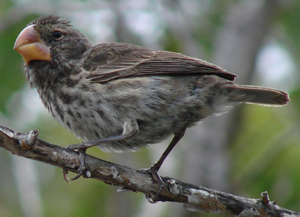 We walked up the beach to the edge of the mangroves where we soon caught a glimpse of the rare Mangrove Finch – first a female, then a male. A Large Ground-Finch also appeared showing its enormous beak. Small Ground-Finches and Small Tree-Finches were here and we worked hard to sort out which was which! As we continued along the beach, we noted a Small Painted locust (as compared to the Large Painted Locusts that were appearing on the boat) and Galápagos Morning Glory. We worked our way back to the water’s edge passing a very large basking Marine Iguana. On some offshore rocks, we could see two Wandering Tattlers, several Blue-footed Boobies, and at least three Flightless Cormorants. Some of us took the shoreline route while others went back along the mangrove line to try to get another glimpse of the Mangrove Finch. We could not relocated the Mangrove Finch but did get close looks at a confiding Medium Ground-Finch, giving us a total of five species of Darwin’s Finches for the morning.
We walked up the beach to the edge of the mangroves where we soon caught a glimpse of the rare Mangrove Finch – first a female, then a male. A Large Ground-Finch also appeared showing its enormous beak. Small Ground-Finches and Small Tree-Finches were here and we worked hard to sort out which was which! As we continued along the beach, we noted a Small Painted locust (as compared to the Large Painted Locusts that were appearing on the boat) and Galápagos Morning Glory. We worked our way back to the water’s edge passing a very large basking Marine Iguana. On some offshore rocks, we could see two Wandering Tattlers, several Blue-footed Boobies, and at least three Flightless Cormorants. Some of us took the shoreline route while others went back along the mangrove line to try to get another glimpse of the Mangrove Finch. We could not relocated the Mangrove Finch but did get close looks at a confiding Medium Ground-Finch, giving us a total of five species of Darwin’s Finches for the morning.
Back at the beach, Madrid and Johnny picked us up with the dinghy to take us out to the San Jose. We spotted a group of Galápagos Penguins in the bay and turned toward them. Just as we did, the group turned toward us and swam right up to the side of our boat. This resulted in fantastic, close photos and one bird that came right to the transom! This bold behavior was a result of curiosity or tameness – we all enjoyed it!
Back on the San Jose, we crossed over to Fernandina noting several of the regulars enroute – Magnificent 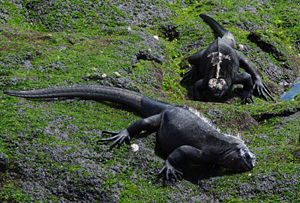 Frigatebird, Brown Noddy, Blue-footed Booby, Galápagos Shearwater, and Eliot’s Storm-Petrel. Once anchored, we took the zodiacs ashore at Punta Espinosa. It was low tide with many bright green algae-covered rocks exposed. As we disembarked, we noticed several Marine Iguanas swimming in the water and several more making their way to the shore. A Green Sea Turtle was trapped in a tide pool until the tide came in and we enjoyed wonderful looks at it. We walked on the lava and marveled at the large Marine Iguanas making their way into the water. Some stopped along the way to gnaw green algae from rocks that were no longer submerged. Others swam out toward the open water and the mass exodus was an amazing spectacle. A distant spout and whale fin drew our attention offshore and it turned out to be a Bryde’s Whale way out in the channel. We scanned to see it again but to no avail.
Frigatebird, Brown Noddy, Blue-footed Booby, Galápagos Shearwater, and Eliot’s Storm-Petrel. Once anchored, we took the zodiacs ashore at Punta Espinosa. It was low tide with many bright green algae-covered rocks exposed. As we disembarked, we noticed several Marine Iguanas swimming in the water and several more making their way to the shore. A Green Sea Turtle was trapped in a tide pool until the tide came in and we enjoyed wonderful looks at it. We walked on the lava and marveled at the large Marine Iguanas making their way into the water. Some stopped along the way to gnaw green algae from rocks that were no longer submerged. Others swam out toward the open water and the mass exodus was an amazing spectacle. A distant spout and whale fin drew our attention offshore and it turned out to be a Bryde’s Whale way out in the channel. We scanned to see it again but to no avail.
We continued our walk on the trail past more large Marine Iguanas, one with a Lava Lizard sitting on top of its head. Some noisy American Oystercatchers flew by as we continued on the trail past a large marker. The trail led to a lone Flightless Cormorant nesting on the lava. As the bird shifted in the nest, we could see at least one 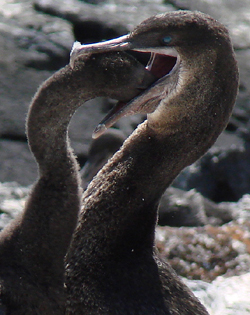 very young chick in the nest. We followed another trail to a breeding colony with several young Flightless Cormorants of varying ages. We were treated to a demonstration of feeding where the chick puts its head down the adult’s throat and feeds on a predigested fish slur. It looked like the adult was eating the chick! We watched the spectacle for awhile and took many photos of yet another wildlife spectacle. The last scene was an adult bringing nesting material and presenting it to its mate in the nest. What a display!
very young chick in the nest. We followed another trail to a breeding colony with several young Flightless Cormorants of varying ages. We were treated to a demonstration of feeding where the chick puts its head down the adult’s throat and feeds on a predigested fish slur. It looked like the adult was eating the chick! We watched the spectacle for awhile and took many photos of yet another wildlife spectacle. The last scene was an adult bringing nesting material and presenting it to its mate in the nest. What a display!
We continued on the trail and got a quick glimpse of a Striated Heron flying off one of the lava flows. A trail took us through a field of pahoehoe lava along a vast expanse of ah-ah lava. The landscape was stark except for some large mangroves colonizing the lava and a few lava cacti. The trail brought us out to another part of the shore where a Great Blue Heron was wading in the water. We noticed our first Spot-winged Glider dragonfly as well. We continued around to a shallow lagoon surrounded by mangroves that had at least five Green Sea Turtles in it. On the way back we could hear a Galápagos Hawk calling from beyond the mangroves. Chris spotted no less than five Galápagos Hawks soaring high in the sky.
We made our way back to the zodiacs and lunch on the San Jose. A post-lunch dinghy ride to explore another area with Mangroves and low lava cliffs yielded close looks at a Great Blue Heron on a nest, more Galápagos Penguins, and more Flightless Cormorants. The contrast of the bright sky, clear blue water, and the black lava was stunning. Back on the San Jose we headed up the channel between Fernandina and Isabela.
We all met on the middle deck for another sunset and gorgeous sky. The beautiful setting combined with the magic of the day and some good music inspired Milady to start dancing. Her moves in turn inspired several of us to join her as well as some of the crew. The highlight was when our captain appeared and joined in dancing with Milady. (Who was driving the boat?) We danced until the dinner bell rang and enjoyed another great meal. After our evening briefing and species list review, several of us went to the upper deck for some star-gazing. Thanks to Gregory’s expertise in astronomy, we saw several of the southern constellations and the Milky Way in the black sky. It was a magical evening!
Friday, July 6, 2007
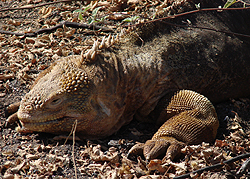 This morning we woke up in Urbina Bay at the foot of Volcan Alcedo on the west coast of Isabela. A large crowd of people from a 90-passenger boat made us appreciate our lovely 16-passenger craft. We made a wet landing on a steep, black sand beach with recent Green Sea Turtle nests at the top and took a trail into the arid scrub. Hot, dry conditions were evident here but there were a number of species including Small, Medium, and Large Ground-Finches as well as Galápagos Mockingbirds. Efrén pointed out Galápagos Cotton and we also got good looks at Galápagos Clouded Sulfur, Monarch Butterfly, and Spot-winged Glider. Mangrove Warblers were common and we got good looks at a Small Tree-Finch which displaced a Small Ground-Finch on a low bush. Just off the trail were our first Land Iguanas – a male and female together. Nearby was a nice-looking Galápagos Dove. Marianne discovered some Giant Tortoise scat on the trail and we continued to check the thick brush for these creatures. We stopped at an opening in the brush where Linda spotted a Dark-billed Cuckoo. We got close looks at the gorgeous peach color on its breast as did a group from the other ship that caught up with us.
While we were enjoying looks at the Cuckoo a Galápagos Hawk flew over as well and a Galápagos Flycatcher flew into a nearby tree.
This morning we woke up in Urbina Bay at the foot of Volcan Alcedo on the west coast of Isabela. A large crowd of people from a 90-passenger boat made us appreciate our lovely 16-passenger craft. We made a wet landing on a steep, black sand beach with recent Green Sea Turtle nests at the top and took a trail into the arid scrub. Hot, dry conditions were evident here but there were a number of species including Small, Medium, and Large Ground-Finches as well as Galápagos Mockingbirds. Efrén pointed out Galápagos Cotton and we also got good looks at Galápagos Clouded Sulfur, Monarch Butterfly, and Spot-winged Glider. Mangrove Warblers were common and we got good looks at a Small Tree-Finch which displaced a Small Ground-Finch on a low bush. Just off the trail were our first Land Iguanas – a male and female together. Nearby was a nice-looking Galápagos Dove. Marianne discovered some Giant Tortoise scat on the trail and we continued to check the thick brush for these creatures. We stopped at an opening in the brush where Linda spotted a Dark-billed Cuckoo. We got close looks at the gorgeous peach color on its breast as did a group from the other ship that caught up with us.
While we were enjoying looks at the Cuckoo a Galápagos Hawk flew over as well and a Galápagos Flycatcher flew into a nearby tree.
We continued on another trail where we saw a small Galápagos Tortoise (Alcedo subspecies). Efrén estimated that it was 15 years old and we were thrilled to get our first look at one of these creatures in the wild. We headed back toward to beach passing another male Land Iguana on the trail near its burrow. We spent some time swimming and snorkeling in the bay noting some large Puffer Fish and large schools of smaller fish in the shallow water.
 We returned to the San Jose and set sail for Punta Moreno on the southwest coast of Isabela. Enroute we saw several Nazca Boobies and, at one point, Chris called us out for a Waved Albatross floating on the surface. We were thrilled with our first views of this massive bird. In the afternoon, we anchored at Punta Moreno on the west side of the Sierra Negra volcano. The landscape was expansive lava fields and mangroves in the shadow of the massive volcano.
We returned to the San Jose and set sail for Punta Moreno on the southwest coast of Isabela. Enroute we saw several Nazca Boobies and, at one point, Chris called us out for a Waved Albatross floating on the surface. We were thrilled with our first views of this massive bird. In the afternoon, we anchored at Punta Moreno on the west side of the Sierra Negra volcano. The landscape was expansive lava fields and mangroves in the shadow of the massive volcano.
After a brief snorkeling excursion, we took the zodiacs through the mangroves to the landing spot. On the way in we passed four Brown Pelicans on nests in the mangroves. As we disembarked, we marveled at the vast lava field here with little more than Candelabra and Lava Cactus, a few Galápagos Sedge, and a lone Lance-leaved Darwin Bush. We started up the trail but a vocal Striated Heron flew across the water and landed in some nearby mangroves drawing us back to the landing spot to see it.
We walked along a trail through the lava field. We could see a group of Magnificent Frigatebirds diving into an area with mangroves, then flying up and shaking off water. As we neared the area, we could see a lagoon with several Greater Flamingos feeding. This veritable oasis held a number of Common Moorhens as well as Black-necked Stilts. The Magnificent Frigatebirds were dunking themselves in the water possibly to bathe and then flying up over the lagoon. We walked around the lagoon and Chris spotted a Pied-billed Grebe. It took a few minutes but eventually the bird showed and we all got looks at two grebes behind two of the flamingos. Cattle Egrets were also seen here and a family of Common Moorhens with two young worked the end of the mangroves near two close flamingos. There were many Spot-winged Glider dragonflies here and we marveled at two more lush oases in the barren lava field.
We continued along the trail back to an inlet from the sea where two White-tipped Reef Sharks were seen swimming among schools of smaller fish. The sharks were close enough to see them very well and we were thrilled at such a good view.
The sun was beginning to set and we made our way to the shoreline. Some large Marine Iguanas were basking on the lava and a curious Galápagos Penguin came to the edge of the water to check us out. On the way back to the San Jose we passed a congregation of at least five large Green Sea Turtles in the bay and watched groups of Blue-footed Boobies flying in formation along the shore. It was another gorgeous evening on the San Jose. From the second deck we could see several Elliot’s Storm-Petrels pattering on the water surface close to the boat. A feeding flock of Galápagos Shearwaters flew in and we enjoyed a feeding frenzy of Magnificent Frigatebirds against the backdrop of another Galápagos sunset. Jefferson put on some Santana and the dancing began. Once again, we danced into the evening until Jefferson rang the bell for dinner. Another marvelous day!
Saturday, July 7, 2007
Our alarm clock this morning was the dropping of the anchor in Puerto Villamil bay. The main settlement on Isabela, Puerto Villamil sits on the south coast below Volcan Sierra Negra. Originally a penal settlement, Puerto Villamil’s colorful buildings, numerous fishing boats, lava islands dotted with mangroves, and turquoise water and beaches on either side of the town dock are quite picturesque. Blue-footed Boobies were in the bay as were Brown Pelicans and our first Lava Gull.
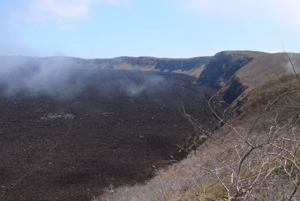 After breakfast, we landed at the town dock and were greeted by several young Marine Iguanas at the base of a sculpture of Ecuador’s first president, José Villamil. We walked up the pier noting a Black-bellied Plover on the beach. We stopped in town to get some supplies and then boarded the bus up to Volcan Sierra Negra. As we ascended, the landscape changed from lava fields and cactus to lush fields and forests. Of particular note were the large bells of the Angel Trumpet bush along the road. As we continued, more ferns were in evidence as well as a few tree ferns. We stopped the van for a close look at a Vermillion Flycatcher whose bright color was dulled by the mist that was setting in. When we arrived at the check-in station, we were surrounded by heavy fog. We drove to an area near a cow field to park and walk up to the caldera of Volcan Sierra Negra. A group of horseback riders passed us on the trail and we thought that would be a nice way to make this ascent. Carlyn spotted a Mangrove Warbler flitting among the lush vegetation and a Small Ground-Finch and some Smooth-billed Anis flew over the trail.
After breakfast, we landed at the town dock and were greeted by several young Marine Iguanas at the base of a sculpture of Ecuador’s first president, José Villamil. We walked up the pier noting a Black-bellied Plover on the beach. We stopped in town to get some supplies and then boarded the bus up to Volcan Sierra Negra. As we ascended, the landscape changed from lava fields and cactus to lush fields and forests. Of particular note were the large bells of the Angel Trumpet bush along the road. As we continued, more ferns were in evidence as well as a few tree ferns. We stopped the van for a close look at a Vermillion Flycatcher whose bright color was dulled by the mist that was setting in. When we arrived at the check-in station, we were surrounded by heavy fog. We drove to an area near a cow field to park and walk up to the caldera of Volcan Sierra Negra. A group of horseback riders passed us on the trail and we thought that would be a nice way to make this ascent. Carlyn spotted a Mangrove Warbler flitting among the lush vegetation and a Small Ground-Finch and some Smooth-billed Anis flew over the trail.
Some of us enjoyed the tasty guava fruits from the trailside trees as we walked. We took a turn off the main trail toward the caldera. As we waited for everyone to catch up, Chris spotted a Vegetarian Finch which took off in a hurry and Carlyn found another Small Tree-Finch. Joe and Donna got up close and personal with a Galápagos Flycatcher.
As we reached the edge of the caldera a thick mist blew in so we went a bit further to try and find a more open area. In between the mist, we could see the vent and flows of the eruption that had occurred 18-months earlier. The expansive caldera is four by five miles wide, second only in size to the Ngorongoro Crater in East Africa. As the mist cleared we could see across the crater to the vegetation line of the last eruption. A sulfur vent still spewing gas reminded us that this area was by no means dormant. Finally the clouds lifted and we were able to see across the caldera. We enjoyed the view and took photos before heading back down to the bus and back to Puerto Villamil. A quick stop at a lagoon in town yielded two Common Moorhens, a Galápagos Pintail, and two Greater Flamingos. We had time for a little more shopping for necessities, a few ice creams, and then went back to the dock. From the dock we had a Ruddy Turnstone and a Whimbrel and we added Great Egret and Royal Tern during our zodiac ride back to the San Jose.
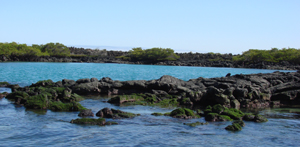 After lunch, some of us opted for an afternoon zodiac ride and snorkeling out it the bay while others rested and scrubbed the ingrained dust off. We headed into an area with lava islands and mangroves. There were several Blue-footed Boobies perched on the rocks, a pair with a nest, and a young white fuzzy baby booby. The birders continued in one zodiac and found a nice Lava Gull, Great Blue Heron, two Black-bellied Plovers, Semipalmated Plover, Whimbrel, and two Ruddy Turnstones on a lava island. In the water were Green Sea Turtles and above us a Royal Tern flew over a few times. The snorkelers were having their own fun with a playful sea lion pup frolicking around them and Chris swam over to get a close look at the Lava Gull. As we headed back to the San Jose, Blue-footed Boobies were plunge-diving all around us. We passed a very close and very vocal Galápagos Penguin calling for its group. Soon it was joined by three more penguins.
After lunch, some of us opted for an afternoon zodiac ride and snorkeling out it the bay while others rested and scrubbed the ingrained dust off. We headed into an area with lava islands and mangroves. There were several Blue-footed Boobies perched on the rocks, a pair with a nest, and a young white fuzzy baby booby. The birders continued in one zodiac and found a nice Lava Gull, Great Blue Heron, two Black-bellied Plovers, Semipalmated Plover, Whimbrel, and two Ruddy Turnstones on a lava island. In the water were Green Sea Turtles and above us a Royal Tern flew over a few times. The snorkelers were having their own fun with a playful sea lion pup frolicking around them and Chris swam over to get a close look at the Lava Gull. As we headed back to the San Jose, Blue-footed Boobies were plunge-diving all around us. We passed a very close and very vocal Galápagos Penguin calling for its group. Soon it was joined by three more penguins.
Back on board, we set off for the long journey to Española. Sea-watching along the way yielded Dark-rumped Petrel, Nazca Booby, Wedge-rumped Storm-Petrel, Elliot’s Storm-Petrel, and Galápagos Shearwater. As darkness fell, we enjoyed another lovely dinner and settled in for the night.
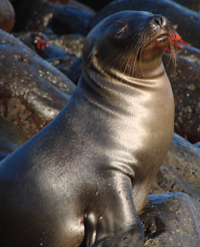 Sunday, July 8, 2007
Sunday, July 8, 2007
At dawn the island of Espanola was in sight and we made our way to the anchorage. We disembarked for our landing spot at Punta Suarez before breakfast so we could be the first to arrive on the island and have it to ourselves. We made a dry landing on a stone dock. A female Sea Lion and two pups were sleeping on the walkway so we had to hobble over the rocks below to get around them. We reached a trail where there was a congregation of Hood Marine Iguanas with their red coloration as well as a curious Hood Mockingbird and a small flock of Galápagos Doves.
A pair of Blue-footed Boobies had decided to make their nest on the trail and as we passed, we were treated to their dancing and sky-pointing displays. Efrén pointed out the difference between the male and female by the size of the black pupil in the eye. There were several more pairs along the trail as well as some very tame Hood Mockingbirds which ran among our feet. The trail overlooked the sea and several Swallow-tailed Gulls perched on the rocks. A Galápagos Fur Seal was hauled out high on a rock overlooking the water and Juan commented that he had not seen this species here previously. Several Nazca Boobies stood among the low vegetation spending most of their time preening their bright white plumage. Chris pointed out a Warbler Finch close to the trail and we got good looks at this species with its diminutive bill and warbler-like flitting habits. There turned out to be several Warbler Finches here, all of the cinserascens subspecies. A Large Cactus-Finch appeared briefly and only a few of us were able to get on it.
 We continued on past a Marine Iguana nesting area up into an open flat area with several pairs of Blue-footed Boobies and Waved Albatross. The boobies danced, whistled, and grunted while the Albatross gave us a show with their bill clacking and courtship displays. A few chicks of each species were evident and we could see some booby eggs. Lava Lizards were also here basking on the rocks and the Hood Mockingbirds seemed to follow us along and demand attention. A few Red-billed Tropicbirds flew overhead. As we reached the edge of the plateau overlooking the sea, we got to see some of the Albatross take off by leaping from the cliff. We stopped for a view and some photos of the famous blow hole which gave its own show. Further on, more Waved Albatross displayed for us and we estimated at least 200 of these massive birds in the area where we walked. We also found their “landing strip,” an open area in the middle of the island. Further on this trail, Juan spotted a Galápagos Hawk perched on a rock. We initially got scope views but as with most Galápagos wildlife, we were able to walk to within a few feet of the bird. As we got close, we could see another Galápagos Hawk on a nest on top of another rock nearby.
We continued on past a Marine Iguana nesting area up into an open flat area with several pairs of Blue-footed Boobies and Waved Albatross. The boobies danced, whistled, and grunted while the Albatross gave us a show with their bill clacking and courtship displays. A few chicks of each species were evident and we could see some booby eggs. Lava Lizards were also here basking on the rocks and the Hood Mockingbirds seemed to follow us along and demand attention. A few Red-billed Tropicbirds flew overhead. As we reached the edge of the plateau overlooking the sea, we got to see some of the Albatross take off by leaping from the cliff. We stopped for a view and some photos of the famous blow hole which gave its own show. Further on, more Waved Albatross displayed for us and we estimated at least 200 of these massive birds in the area where we walked. We also found their “landing strip,” an open area in the middle of the island. Further on this trail, Juan spotted a Galápagos Hawk perched on a rock. We initially got scope views but as with most Galápagos wildlife, we were able to walk to within a few feet of the bird. As we got close, we could see another Galápagos Hawk on a nest on top of another rock nearby.
We made our way back to the landing spot passing many more Marine Iguanas and Sea Lions on the beach. Our faithful zodiac drivers brought us back to the San Jose for breakfast and we pulled anchor and set off for San Cristóbal – a four hour journey. Several of us took the opportunity to nap while others read and watched the sea. A group of Wedge-rumped Storm-Petrels followed the ship and we could see Galápagos Shearwaters and a few Dark-rumped Petrels as we traveled.
Soon San Cristóbal came into view and we anchored in the busy harbor with several other ships. After lunch we went ashore, landing on the town dock at Puerto Baquerizo Moreno, the provincial capital of the Galápagos. Carlyn pointed out some Brown Pelicans on the rocks and there were a few San Cristóbal Marine Iguanas and some Sea Lions. We met a bus that took us up into the highlands. As we ascended there were small groups of Smooth-billed Anis along the way. Juan spotted a Chatham Mockingbird sitting on a power line and we stopped to scope it. It cooperated for a short time and flew off leaving some of us with only binocular views. A little further on, Gina spotted one on a power pole and we backed up the bus and scoped it for the rest of us to see. These semi-distant views were only the beginning for this sometimes elusive species. During the course of the afternoon, we got several more close views of these birds – 15 in all!
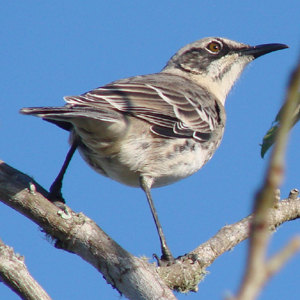 We continued into the interior of the island noting Cattle Egrets, Small Ground-Finches and Galápagos Doves along the road. We stopped for a tour of a breeding facility for Galápagos Tortoises and walked a lovely trail which not only had tortoises but also Mangrove Warbler, and Small and Medium Ground-Finches. We were thrilled to get nice close looks and some photos of a Woodpecker Finch (striatipectus subspecies) along the trail. A group of Chatham Mockingbirds came into a tree over the trail making a racket and were soon joined by six Mangrove Warblers and several Ground-Finches. We continued to the end of the trail and checked the pens for the small tortoises ranging from 3 months to 18 months old. The center had a nice interpretive building that described the efforts to protect the island’s subspecies of tortoise.
We continued into the interior of the island noting Cattle Egrets, Small Ground-Finches and Galápagos Doves along the road. We stopped for a tour of a breeding facility for Galápagos Tortoises and walked a lovely trail which not only had tortoises but also Mangrove Warbler, and Small and Medium Ground-Finches. We were thrilled to get nice close looks and some photos of a Woodpecker Finch (striatipectus subspecies) along the trail. A group of Chatham Mockingbirds came into a tree over the trail making a racket and were soon joined by six Mangrove Warblers and several Ground-Finches. We continued to the end of the trail and checked the pens for the small tortoises ranging from 3 months to 18 months old. The center had a nice interpretive building that described the efforts to protect the island’s subspecies of tortoise.
We boarded the bus and headed back to town. We had some time to explore the quaint village and then boarded the zodiacs back to the San Jose. We had another delicious dinner followed by a briefing on the next day’s activities and a review of the great species we had today. As we went to bed, the ship’s engines started up for the long journey to Floreana.
Monday, July 9, 2007
After a rough and tumble overnight journey we arrived at Floreana at sunrise. We circumnavigated Isla Champion at 6 AM to look for the rare and localized Floreana Mockingbird. The captain kept the boat close to shore and we were pleased to find six of these birds flitting among the cactus and on the ground. Also on the island were Nazca Boobies, Blue-footed Boobies, Common Noddy, and Magnificent Frigatebird, and in the offshore waters were several Wedge-rumped Storm-Petrels.
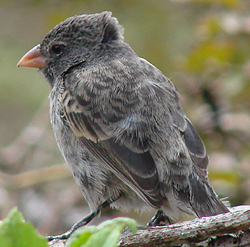 During breakfast, we moved to Puerto Velasco Ibarra and went ashore. The usual Sea Lion contingent greeted us on the dock and we climbed into our van to head to the interior of the island. We traveled up to the highlands noting several finches along the road as well as Smooth-billed Ani and a quick glimpse of a Dark-billed Cuckoo. We stopped at one point on the road and got out of the van to walk. In a few minutes, Juan found a Medium Tree-Finch, our quarry here as it occurs no where else. If flew quickly across the road and we lost it for a moment until Marianne said, “Turn around slowly, it’s in a tree behind us” and there it was. We got good looks at both a male and a female. The male had three leg bands — evidence of the research that is being done on this rare species. We walked the road and then a small trail off the road and found Small and Medium Ground-Finch, Galápagos Flycatcher, Mangrove Warbler, and Large Tree-Finch. John found a Spotless Ladybug on the ground, our first of the trip.
During breakfast, we moved to Puerto Velasco Ibarra and went ashore. The usual Sea Lion contingent greeted us on the dock and we climbed into our van to head to the interior of the island. We traveled up to the highlands noting several finches along the road as well as Smooth-billed Ani and a quick glimpse of a Dark-billed Cuckoo. We stopped at one point on the road and got out of the van to walk. In a few minutes, Juan found a Medium Tree-Finch, our quarry here as it occurs no where else. If flew quickly across the road and we lost it for a moment until Marianne said, “Turn around slowly, it’s in a tree behind us” and there it was. We got good looks at both a male and a female. The male had three leg bands — evidence of the research that is being done on this rare species. We walked the road and then a small trail off the road and found Small and Medium Ground-Finch, Galápagos Flycatcher, Mangrove Warbler, and Large Tree-Finch. John found a Spotless Ladybug on the ground, our first of the trip.
We headed back to town and stopped in at the Hotel Wittmer to look at the display about the history of Floreana. Some of us got our much-appreciated dog and cat fixes with some local pets. The hotel, now run by the daughter and granddaughter of Margaret Wittmer overlooked a beautiful black sand beach and had a large Galápagos Tortoise in a pen in the back.
 From here we went back to the San Jose for lunch and sailed over to Punta Cormorant located between two tuff cones on the north side of Floreana. We made a wet landing and walked up to an area of the beach that was loaded with green olivine crystals on the beach. Beyond the beach were some mangroves and a large salt lagoon with 32 Greater Flamingos feeding. Also in the lagoon were a number of Galápagos Pintails and Chris spotted a distant Black-necked Stilt. Flying over the lagoon was our first Great Frigatebird of the trip, a female, identified by its white throat patch. We hiked across the island to a white sand beach where there were several Sea Turtles and Diamond Sting Rays in the surf. Steve noted some small dried-up Portuguese Man-of-Wars on the beach. Across the water, we could see Champion islet where we were this morning. The views were stunning.
From here we went back to the San Jose for lunch and sailed over to Punta Cormorant located between two tuff cones on the north side of Floreana. We made a wet landing and walked up to an area of the beach that was loaded with green olivine crystals on the beach. Beyond the beach were some mangroves and a large salt lagoon with 32 Greater Flamingos feeding. Also in the lagoon were a number of Galápagos Pintails and Chris spotted a distant Black-necked Stilt. Flying over the lagoon was our first Great Frigatebird of the trip, a female, identified by its white throat patch. We hiked across the island to a white sand beach where there were several Sea Turtles and Diamond Sting Rays in the surf. Steve noted some small dried-up Portuguese Man-of-Wars on the beach. Across the water, we could see Champion islet where we were this morning. The views were stunning.
Back to the olivine beach, we took advantage of the opportunity to swim and snorkel. Some of us took a zodiac over to Devil’s Crown to snorkel and were thrilled with looks at several Sea Turtles, Sea Stars, colorful fish, and a Moray Eel as well as interesting coral formations. Above us, several vocal Red-billed Tropicbirds flew back and forth between the lava outcroppings.
Back on board the San Jose, we met on the upper deck for a beautiful sunset and to reminisce about our fantastic tour of the Galápagos. Each of us chose one of the animals to act out. Milady was a Medium Tree Finch, Tom a Puffer Fish, Joe a Marine Iguana, Joanna a Blue-footed Booby, Donna a Sea Turtle, John a Sea Lion, Marie a Magnificent Frigatebird as she was dressed in the right colors, Steve a Sea Star, Linda a Galápagos Penguin, Juan a Flightless Cormorant, Carlyn a very fitting Mangrove Warbler, Gina a Flamingo, Chris a Galápagos Hawk, Monica a Galápagos Fur Seal, and Marianne a Manta Ray. We elected Gregory the trip’s Charles Darwin. The ships crew joined us for a farewell cocktail and we performed our animals for them. The next day, Madrid said that he had never seen a group of passengers put on such a performance!
Tuesday, July 10, 2007
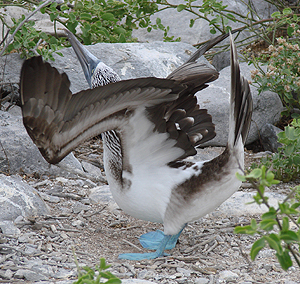 After a very calm night of sailing, we arrived at North Seymour and were anchored offshore when the sun came up. We went ashore as the gorgeous sunrise lit the flat-topped island. As usual, there were several Common Noddies feeding along the shore as we approached the island. At our landing site, a pair of Swallow-tailed Gulls was allopreening and we noticed several more pairs nesting in the lava ledges. A few steps up the trail we entered a Blue-footed Booby nesting area with numerous nests with eggs and young of all ages including some that had fledged and were trying their wings around us. There were also several Magnificent Frigatebird nests and some of the males were displaying with their gular pouches inflated. Great Frigatebirds were also here and we were able to get close enough to see the eye ring of the females and the green sheen on the back of the males. There were numerous photo opportunities here as several of the nests had young in them.
After a very calm night of sailing, we arrived at North Seymour and were anchored offshore when the sun came up. We went ashore as the gorgeous sunrise lit the flat-topped island. As usual, there were several Common Noddies feeding along the shore as we approached the island. At our landing site, a pair of Swallow-tailed Gulls was allopreening and we noticed several more pairs nesting in the lava ledges. A few steps up the trail we entered a Blue-footed Booby nesting area with numerous nests with eggs and young of all ages including some that had fledged and were trying their wings around us. There were also several Magnificent Frigatebird nests and some of the males were displaying with their gular pouches inflated. Great Frigatebirds were also here and we were able to get close enough to see the eye ring of the females and the green sheen on the back of the males. There were numerous photo opportunities here as several of the nests had young in them.
We walked a trail along the beach— the sky was now brilliant blue and crystal clear. Sea Lions, Mangrove Warblers, a few Galápagos Doves, and a Small Ground-Finch making a nest in a cactus rounded out the wildlife here. And, we got close looks at one large Land Iguana along the trail. By the time we reached the landing site, a large cruise ship had dropped what seemed like hundreds of passengers on shore. We were glad we chose to visit this magical place at first light and have it to ourselves.
Back on the San Jose it was time to pack and say our goodbyes to our excellent crew. We loaded the zodiacs and went to the north side of Santa Cruz Island where we boarded a van to take us to Puerto Ayora on the south side of the island.
We made a stop at Los Gemelos to see the famous pit craters which were an awesome sight. The area here was an excellent example of Scalesia forest – a lush cloud forest with dense stands of bright green scalesia trees. Their trunks were encrusted with epiphytes, mosses, liverworts, bromeliads, and orchids. On the trail we had a Large Ground-Finch, Vegetarian Finch, and Small Tree-Finch.
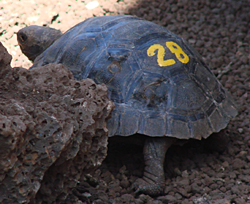 We continued down to the Charles Darwin Research Station where we got out to explore the facility. Almost immediately, we found our target bird, a Cactus Finch, on the ground near the side of the road. We walked to the center where Efrén told us of the breeding efforts here and we toured the tortoise rearing pens as well as the holding pens for these awesome creatures. We stopped for a look at the famous Lonesome George and reviewed his story. We were able to walk in among the older tortoises that seemed indifferent to our presence.
We continued down to the Charles Darwin Research Station where we got out to explore the facility. Almost immediately, we found our target bird, a Cactus Finch, on the ground near the side of the road. We walked to the center where Efrén told us of the breeding efforts here and we toured the tortoise rearing pens as well as the holding pens for these awesome creatures. We stopped for a look at the famous Lonesome George and reviewed his story. We were able to walk in among the older tortoises that seemed indifferent to our presence.
Later in the morning we checked into our lovely hotel in Puerto Ayora. After an excellent lunch in town we had the afternoon free to explore this bustling town. Some went to the fishing dock and watched Sea Lions fighting with Pelicans for fish scraps. Some went shopping along the main street of Puerto Ayora. Some enjoyed the scene at the waterfront of the town. We met again later at the hotel for dinner and then some of us went out again for a taste of the nightlife in town.
Wednesday, July 11, 2007
After breakfast, we loaded the bus and headed into the highlands of Santa Cruz. We passed through the small town of Bellavista and picked up Efrén and continued on a dirt road right past his house. We ascended into the hills passing banana and coffee plantations and arrived at a parking area at the National Park boundary. We continued to walk up into a Miconia forest to the fern zone. The introduced and invasive Quinine Tree was here and Efrén explained how this tree was threatening the native vegetation. As we walked, a group of workers passed us heading into the forest to remove the Quinine.
We walked up to an area called Media Luna toward Cerro Crocker, the highest point on Santa Cruz at 864 meters. Our quarry here was the elusive Galápagos Rail, a very small, secretive bird now restricted to the Fern and Miconia Zones. We tried for the rail in several locations with no success though did have good looks at some close Warbler Finches and Mangrove Warblers. As we turned around to head back down the trail, Juan heard a Galápagos Rail calling off the trail so we went into a small side trail to try to see it. We sat quietly for several minutes and at one point there were three rails calling around us. They came in very close (based on call) but we never got a glimpse of one. Patience wearing thin, we started down the trail. In a few steps, we heard the rail call again and this time one bird came close to the main trail, calling as it came closer. Those of us that remained behind stood at the edge of the trail scanning the thick brush. We had many glimpses of the little mouse-like bird running on the ground and eventually we all got satisfying looks at this little gem. Efrén went to get Chris and the others a bit further down the trail and they returned to our spot. Juan followed the bird and was able to show it to everyone there - a victory as this is a very difficult bird to see!
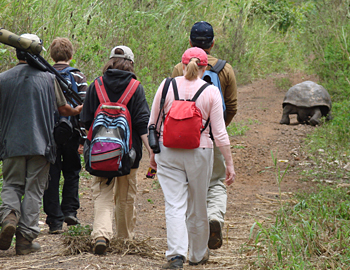 We moved on to a private ranch near Santa Rosa and drove along some small roads through the property. Soon we spotted several Giant Tortoises in the fields with Cattle Egrets among them. We were eager to get out and walk among these awesome creatures, and the driver dropped us off to walk through the trails. Soon we were face-to-face with Giant Tortoises on the road! They were an awesome sight and very photogenic, even though they would withdraw their heads and legs when you got close to them. Some of them made hissing sounds that sounded a bit like Darth Vader and a few did a display of raising and lowering the back end.
We moved on to a private ranch near Santa Rosa and drove along some small roads through the property. Soon we spotted several Giant Tortoises in the fields with Cattle Egrets among them. We were eager to get out and walk among these awesome creatures, and the driver dropped us off to walk through the trails. Soon we were face-to-face with Giant Tortoises on the road! They were an awesome sight and very photogenic, even though they would withdraw their heads and legs when you got close to them. Some of them made hissing sounds that sounded a bit like Darth Vader and a few did a display of raising and lowering the back end.
We walked past several Tortoises on the road and took many photos of these grand reptiles. Some people stayed with the tortoises waiting for them to put their heads back out. Donna even got a photo of two tortoises copulating! No wonder we had to send a search party back for her!
We arrived at the main buildings of the ranch where our bus was waiting to take us to a nearby lava tube. We walked down into this remnant lava river, now a hollow half-mile long cave. Though it was lit by a series of light bulbs, negotiating the lava tube was a challenge for some of us, especially when we had to crawl under a low opening. We finally got through the tube and our bus was waiting at the end to take us to the ranch for lunch. Chris spotted some Vegetarian Finches from the lunch table as they were feeding on the Red Coral Bean flowers. There were also several Small and Medium Ground-Finches in the open air restaurant. There were two large Giant Tortoise shells in the restaurant and some of us could not resist trying them on for size.
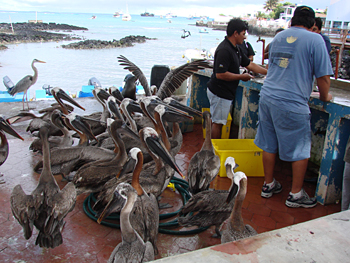 After lunch, we walked some trails on the ranch and enjoyed more looks at the many Giant Tortoises here. We visited a mud pond where several wallowed. There were a few birds along the trails including a male Large Tree-Finch, more Vegetarian Finches. At a mostly dried-up pond, we saw several active Galápagos Pintails and Common Moorhens. In the trees and shrubs around the pond, we saw Galápagos Mockingbird, Galápagos Dove, and several more finches. Cattle Egrets few in and out and more Tortoises were spotted across the pond.
After lunch, we walked some trails on the ranch and enjoyed more looks at the many Giant Tortoises here. We visited a mud pond where several wallowed. There were a few birds along the trails including a male Large Tree-Finch, more Vegetarian Finches. At a mostly dried-up pond, we saw several active Galápagos Pintails and Common Moorhens. In the trees and shrubs around the pond, we saw Galápagos Mockingbird, Galápagos Dove, and several more finches. Cattle Egrets few in and out and more Tortoises were spotted across the pond.
After our hike, the bus took us back to Puerto Ayora where we had a little more time to explore the shops, check the action at the fish market, and stroll the waterfront. We had our final dinner in the Galápagos at Restaurant Hernan and said our goodbyes to our wonderful guide Efrén. Then a few of us checked out the night life in town.
Thursday, July 12, 2007
Today we had to say goodbye to the magical Galápagos Islands. Chris took advantage of our later morning departure with a long walk along the waterfront to catch some last looks at Lava Gull, Lava Heron, Magnificent Frigatebird, Brown Pelican, and Galápagos Sea Lion. After breakfast, we loaded our luggage on the bus and headed north through Santa Cruz to the ferry landing for Baltra. On the way, there were a few Galápagos Mockingbirds along the road and one Dark-billed Cuckoo crossed in front of us. At the ferry landing, we got our last looks at Blue-footed and Nazca Booby flying over, Brown Noddy, Elliot’s Storm-Petrel, and Magnificent Frigatebird. We loaded on the ferry to Baltra and enjoyed a last few minutes on a boat in the Galápagos. From there we traversed Baltra to the airport, checked in for our flight, and had some time for last-minute shopping and reminiscing about our wonderful journey. We arrived in Quito in late afternoon and were met by our steadfast driver, Wilson, who took us back to El Jardin for the night. We settled in and enjoyed the lovely grounds while the sun set. As the stars rose, we took out a scope for a look at Jupiter’s moons and the crescent of Venus. Then we enjoyed our final dinner together at El Jardin with a celebration of an exceptionally successful trip with a wonderful group of traveling companions in a magical setting. We also toasted Steve’s retirement from teaching. And, we raised our glasses of champagne for Steve and Linda’s 35th wedding anniversary, Donna’s 25th wedding anniversary, and Tom and Marie’s 20th wedding anniversary, all of which occurred during the trip. We said our goodbyes to John who was leaving early in the morning and wrote our sentiments in the El Jardin guest book. One last check of the list and we 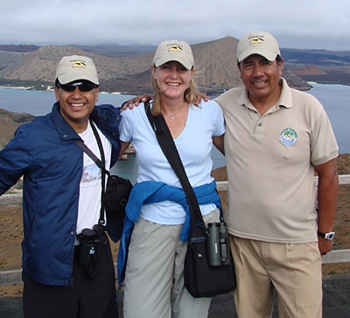 concluded our adventure at the lovely B&B.
concluded our adventure at the lovely B&B.
Friday, July 13, 2007
This morning we said goodbye to Chris, Marianne, Gregory, and Monica. The rest of us took a day trip to the Otavalo area with Norby. We thoroughly satisfied our shopping needs both at the Otavalo market and Cotocachi, the leather town. On the way back to Quito we said goodbye to Joe at the airport and headed to El Jardin for our final night. Early the next morning, Marie, Tom, Donna, Milady, Joanna, and Carlyn said goodbye. Steve and Linda stayed for a few more hours and Steve took advantage of the time to ride two of Juan’s horses. By late morning, Steve and Linda departed for the airport.
This was truly a wonderful group of people to travel with and share the wonders of the Galápagos. Our Galápagos guide Efrén was excellent and Juan Carlos is the best. Thank you all for a fun-filled tour with memories that will last a lifetime!
